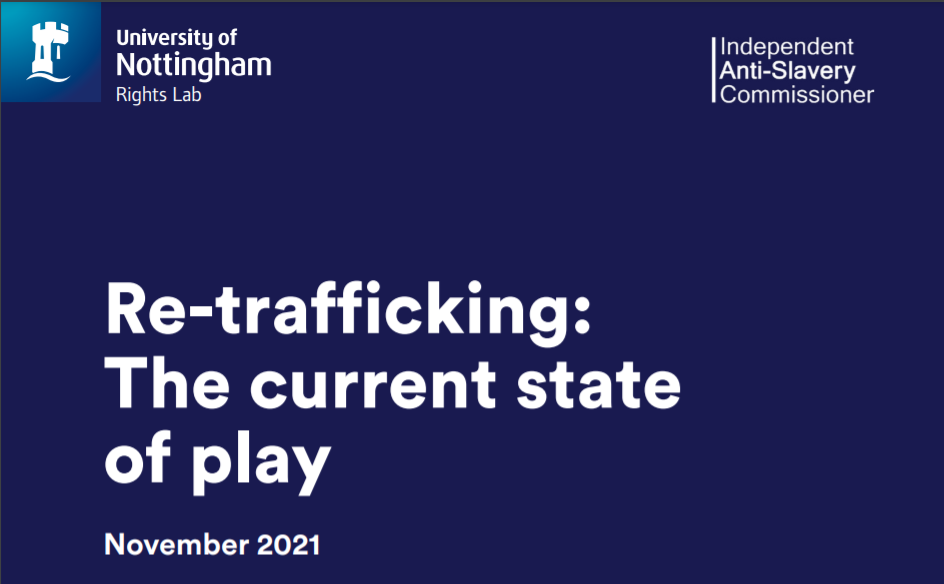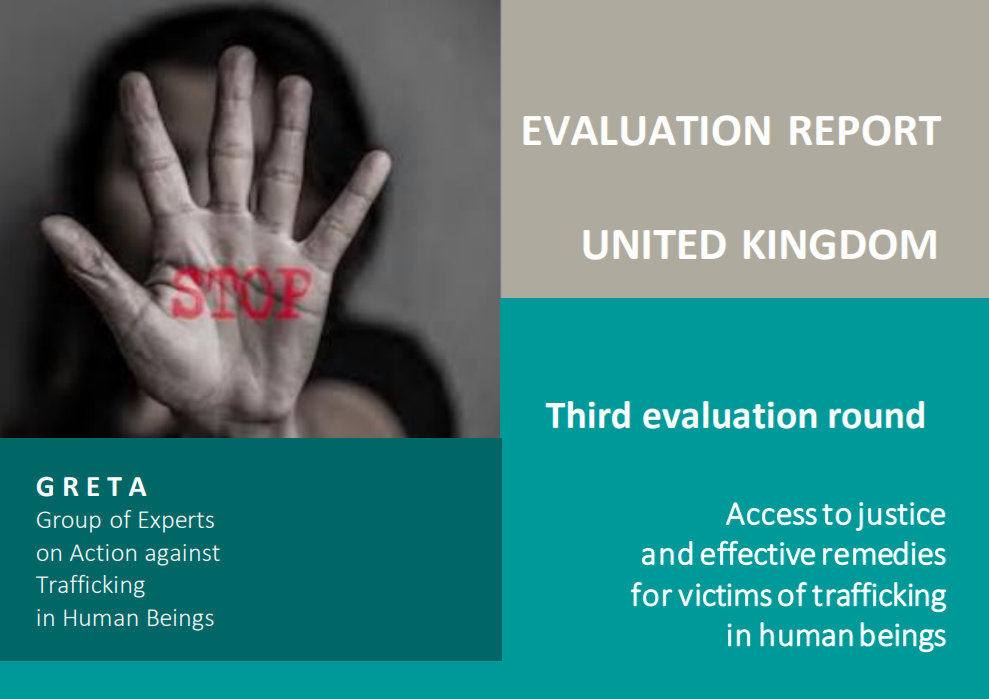‘Re-trafficking: The current state of play’ is a new report published by the Independent Anti-Slavery Commissioner, Dame Sara Thornton, and the University of Nottingham Rights Lab.
The report examines the evidence, data and literature on re-trafficking, and was commissioned in response to lack of emphasis on preventing re-trafficking shown by policymakers and government. The Independent Anti-Slavery Commissioner states that the knowledge base on re-trafficking is largely anecdotal and as there is no agreed definition of re-trafficking there are further difficulties in attempts to collect and assess re-trafficking data.
The report declares that does not propose recommendations but highlights three areas to be explored further in order to better understand re-trafficking. Those three areas are:
- Establishing a definition of re-trafficking
- Addressing the lack of data on prevalence of re-trafficking
- Developing dedicated reintegration pathways for survivors remaining in the UK or returning to another country
For the full report, please see here.
You can also find the press release for the report here.
The Council of Europe’s Group of Experts on Action against Trafficking in Human Beings (GRETA) has published its third report on the United Kingdom.
The core recommendation of the report is that the UK should improve the identification of trafficking victims. The report notes the low level of convictions compared to the number of identified victims, and highlights the effect of the cuts to funding for the criminal justice system and the resulting insufficient resources. Therefore, the report emphasis that free and timely legal aid should be provided to victims of human trafficking, whilst psychological assistance
For the full findings and recommendations please see the report here.
The UK Home Office has published the most recent Modern Slavery Statistics, covering quarter 3 of 2020 (July – September).
Home Office reports that 2,506 potential victims of modern slavery were referred to the NRM. 1,224 (29%) of the NRM referrals claimed exploitation as adults whilst 1,159 (46%) claimed exploitation as children. For 5% of the referral their age at exploitation was unknown.
Overall, of the 2,506 potential victims referred in this quarter, 74% (1,853) were male and 26% (647) were female; these proportions are similar to the previous quarter. For adult potential victims, 69% (849) were male and 31% (374) were female, whilst for child potential victims, 79% (912) were male and 21% (242) were female.
The statistics flag the issue of ‘county lines’ exploitation of children – with 401 referrals flagged as county lines referrals, accounting for 16% of all referrals received in the quarter. The majority (82%; 328) of these referrals were made for male children.
UK, Albanian and Vietnamese citizens remain the most common nationalities referred to the NRM.
For detailed statistics please see the government website here.
The National Referral Mechanism (NRM) is the UK framework for identifying and referring potential victims of modern slavery and ensuring they receive the appropriate support. This statistical bulletin gives a summary and breakdown of the number of potential victims of modern slavery referred into the National Referral Mechanism from 1 January to 31 March 2020 (quarter 1).
Follow this link for the NRM Statistics UK, Quarter 1 2020 – January to March.
The National Crime Agency‘s NRM statistics have been published in their report National Referral Mechanism Statistics covering the year from April 2016 – 2017. Key statistics are as follows:
- 1631 potential victims were submitted to the National Referral Mechanism during the period January to March 2018; an 11% increase from the previous quarter October to December 2017.
- Reporting showed potential victims of trafficking originating from 87 different countries this period.
- Nationals from Albania, the UK and Vietnam remain the most commonly reported, with the United Kingdom being the most referred for the second consecutive quarter.
- The most recorded exploitation type for potential victims exploited as an adult was labour exploitation.
- The most prominent exploitation type recorded for potential victims first exploited as a minor was labour exploitation, which includes criminal exploitation such as cannabis cultivation and County Lines drugs supply.
- One case has been referred this quarter where the potential victim claimed their organs were to be harvested. Whilst no harvesting occurred, the case is under investigation to inform the conclusive grounds decision.
- Over one quarter of referrals received this quarter had no claimed exploitation within the United Kingdom.
- Seven potential victims were referred for crime recording purposes to Northern Ireland, with 53 to both Scotland and Wales. The remaining 1518 were referred to police forces in England.
For the full National Referral Mechanism Statistics 1st Quarter 2018 – January to March, see here.
The report A Game of Chance? Long-term support for survivors of Modern Slavery Dr. Carole Murphy at The Centre for the Study of Modern Slavery offers a comprehensive analysis into the UK’s current approach to support for victims of human trafficking and modern slavery. It highlights the significant gaps in survivor care, most notably in long-term support. There is little done beyond the 45 day reflection and recovery period of the National Referral Mechanism, after which financial assistance ends and survivors are vulnerable to re-trafficking and exploitation. Hence, the report suggests the “system and its processes and procedures are not fit for purpose and have the potential to cause harm to survivors through re-traumatisation, falling through gaps in service provision and potential re-exploitation.”
The key recommendations are:
- Resource services to work with complexity of survivors’ needs relevant statutory and voluntary sector
- A positive Conclusive Grounds (CG) decision must carry status and resources (see Lord Mc Coll’s (Victim Support) Bill)
- Trafficking Survivor Care Standards (HTF) should be implemented as standard model of best practice and should consider introduction of independent advocates
- Statutory guidelines should be introduced and monitored and include compulsory and embedded training for all First Responders and other statutory services
- Personnel conducting CG interviews should be properly trained
- Undertake consistent monitoring of the NRM drawing on evidence based research about what works
- Document evidence of what works by conducting a cost benefit analysis to establish the social return on investment of longer-term support provision
- Consider evidence and best practice from other jurisdictions to inform changes
For the full report on A Game of Chance? Long-term support for survivors of Modern Slavery by Dr. Carole Murphy The Centre for the Study of Modern Slavery, read here.
The National Crime Agency‘s NRM statistics have been published in their report National Referral Mechanism Statistics covering the year from April 2016 – 2017. Key statistics are as follows:
- 3085 victims were submitted to the NRM in 2016, a 17% increase from 2015.
- Of these 3085 potential victims, 150 were from Scotland, 123 from Wales and 33 from Northern Ireland. The remaining 3499 were referred from England.
- Reporting showed potential human trafficking victims from 108 nationalities.
- Albanian, UK and Vietnamese are the most commonly reported victims.
- The most common exploitation type for potential victims recored as an adult was labour exploitation, including criminal exploitation.
- The most common exploitation type for potential victims first recored as a minor was labour exploitation, including the sub category of criminal exploitation, such as cannabis cultivation.
- The minor exploitation referrals in the UK increased 30% to 1278 in 2016, compared to 982 in 2015.
For the full National Referral Mechanism Statistics April 2016 – 2017, see here.
The National Referral Mechanism (NRM) is a framework for identifying victims of human trafficking or modern slavery and ensuring they receive the appropriate support.
The NRM is also the mechanism through which the Modern Slavery Human Trafficking Unit (MSHTU) collect data about victims. This information contributes to building a clearer picture about the scope of human trafficking and modern slavery in the UK.
The NRM was introduced in 2009 to meet the UK’s obligations under the Council of European Convention on Action against Trafficking in Human Beings. At the core of every country’s NRM is the process of locating and identifying “potential victims of trafficking”.
From 31 July 2015 the NRM was extended to all victims of modern slavery in England and Wales following the implementation of the Modern Slavery Act 2015.
For the full competent authority guidance, read here.

